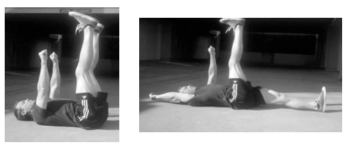What My Baby Boy Taught Me About Core Training
Jan 14, 2015
[caption id="attachment_2481" align="alignleft" width="350"] Not a pic of my son- stock photo - just in case you were wondering. :-)[/caption]
Not a pic of my son- stock photo - just in case you were wondering. :-)[/caption]
It’s funny what you can learn from the world around you if you just pay attention - just be still and observe what’s going on. And ask questions of course.
When my son was a baby, he used to do this really funny thing when he was on the changing table - he’d “flap” his arms and legs in and out - arms would go over his head and he’d outstretch his legs simultaneously. Then he’d pull them back in toward the center of his body.
In and out. In and out. In and out.
I thought it was just funny at first.
Then I started paying closer and more careful attention.
This was mid-2011 and I had already spent a over a year doing the main OS resets. My favorite was loaded Spider-Man Crawling. I’d put a harness on and crawl dragging a weighted sled behind me. It always felt great. And it helped restore my reflexive stability and strength. Most of it.
However, something was missing.
When I did unloaded - bodyweight Spider-Man Crawling - more often than not my left hip/lower
back would “pop” every time I straightened my left leg. “Pop.” “Pop.” “Pop.” It was annoying. It never hurt. But I knew it was an indicator and that something needed to be addressed. After all, that was the side where I tore my oblique back in 2000. Sure, I did my rehab, but I never really felt “restored.”
Turns out it was most likely my hip flexor competing with my abs trying to stabilize my pelvis while my hip was moving.
And that’s when the “a-ha” moment hit.
Two “a-ha” moments actually.
The first was that I needed to do something else other than the resets. What? Well I was very well versed with core stability training and nothing seemed to fit my needs.
The second was my son’s development. He “flapping” was actually a pre-programmed way for him to start training and strengthening his core musculature.
So, I looked at my needs and I looked at what my son was doing and did what he did. Well, almost.
Since my arms and legs are longer, larger, and heavier in relationship to my midsection when compared to a baby’s, I could “flap” just like he did. Doing so is a sure way to a back injury, especially when you already have a back injury.
Therefore I looked at the corrective core stability exercises I already knew and decided that Dead Bugs were the perfect fit as a “regression” to the crawling reset.

However, I didn’t do them in the traditional manner - actively depressing the rib cage and contracting the abs, before initiating each movement. When watching my son, I noticed that his tailbone never touched the changing table. This of course makes sense - he hadn’t developed his spinal curves yet. So having that tailbone off the table made the abdominal muscles work harder.
Rather, when I did my Dead Bugs all I tried to do was keep my tailbone off the ground. What I noticed was that my abs contracted HARD and reflexively - meaning, I didn’t have to think about making them work or pre-tense/contract them volitionally. They just did what they were designed to do - work without me thinking about making them work.
Interestingly enough, Tim, Mike McNiff, my wife and I, had all spent the previous year not only using the resets in our own training, but in our clients’ and patients’ training and rehab. (My wife is a physical therapist.) We saw amazing success - people recapturing their strength and lost movement abilities. However, we noticed that some people, some of the time, about 20%, weren’t fully regaining what they’d lost. They’d get most of it back, but not all of it.
Kind of like me and the Spider-Man Crawling and the Dead Bugs.
What we discovered is that each of the resets has a number of “regressions” - or pieces of the reset that we “used” as babies and toddlers, during the first 3 years or so of our lives, to progress from lying to upright and walking.
These regressions are what we cover in our Foundations Level 1 Workshop. We cover what they are, how to do them, and what they’ll do for your body. And each person gets to test out each regression themselves, to determine whether they need them or not. And they learn a very simple way to make that determination.
If you’d like to learn the Reset Regressions, and how they’ll benefit you or your customers, clients, or patients, then sign up for one of our Level 1 Foundations Workshops here.
If you’re in Southern California (or close to it), we still have some spots in our Ventura Workshop on Saturday, January 24th. If you can make it, we’d love to see you there. Register here.
And if you're anywhere near the Orlando, Florida area, we have some spots open at our upcoming workshop at Crossfit Battlecry on Saturday, January 24th. We'd love to see you there. Register here.

Comments (0)
Please login to comment.